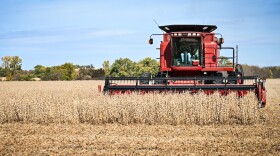-
This Week in Oklahoma Politics discusses the resignation of Transportation Secretary Tim Gatz, State Senator Tom Woods doubling down on calling members of the LGBTQ community "filth" and more.
-
The Federal Trade Commission and 9 states want to stop the deal that would combine the country's two largest grocery store chains. The companies say they have to merge to compete with Walmart.
-
After long delays in considering any tax cut measures, the Senate passed an elimination of the state portion of the sales tax on groceries. Next on the menu for the House is an income tax cut, but Senate leadership has no appetite for cutting more revenue streams.
-
A Senate panel on Monday passed a bill that would prohibit alcohol sales at self-checkout stations.
-
This Week in Oklahoma Politics panel discusses Attorney General Gentner Drummond dropped a second lawsuit by Gov. Kevin Stitt over misspend COVID-19 education funds, a multicounty grand jury indicts three people with Swadley's Bar-B-Q in regard to controversial operations at state park restaurants and Senate President Pro Tem Greg Treat using a report on food prices to push for a grocery sales tax.
-
America's two largest supermarket chains have struck a $25 billion deal to combine. Now the FTC is about to decide whether it will block or allow it, and under what conditions.
-
The agriculture department’s annual projections show a slowing economy and lower crop prices for the upcoming year. The USDA also looks ahead to the next decade, showing rising crop yields but a competitive job market.
-
Rural areas are losing grocery stores to consolidation faster than their urban counterparts — but some communities have come up with innovative solutions.
-
A lot of people don't think twice about buying milk, says Teresa Calderez. "But there are lots of us out here who can't buy a gallon of milk when we need it."
-
While food prices won’t rise as sharply in 2023, they could still increase about 8% over last year’s rates, according to forecasts from the U.S. Department of Agriculture.
Play Live Radio
Next Up:
0:00
0:00
Available On Air Stations









